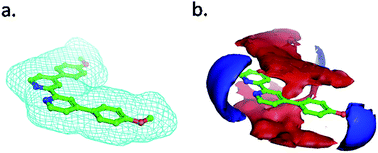Quantitative structure–property relationship modeling of ruthenium sensitizers for solar cells applications: novel tools for designing promising candidates†
Abstract
To date, the most common way of screening new potential sensitizers for dye sensitized solar cells is via the traditional time and money consuming trial and error approach. In this study we explore the possibility of extending drug discovery and cheminformatic approaches to the field of material science with the aim of a quantitative structure–property relationship elucidation that could lead to a fast and inexpensive in silico screening of new ruthenium sensitizers for third generation solar cells. Starting from the building of a database of already tested candidates used to train the predictive models, appropriate descriptors extracted from images of 3D molecular interaction fields (GRID/MIFs), as well as semi-empirical calculated descriptors, were chosen to describe the target structures. Then, structure–performance (Jsc, Voc and PCE) models were built and analysed in order to elucidate structure–property relationships and interesting results were obtained. In particular, we were able to find the molecular descriptors that more contribute to enhance the performance investigated, thus finding directives for the design of potentially high-performing candidates. We also proposed an efficient correction of the experimental Jsc and Voc based on the quantity of the LiI additive for electrolyte used to build the devices. In the early stage of this project, we demonstrated that molecular modelling methods could be successfully extended to the field of material science as alternative to the traditional expensive and time-consuming trial and error approach.


 Please wait while we load your content...
Please wait while we load your content...